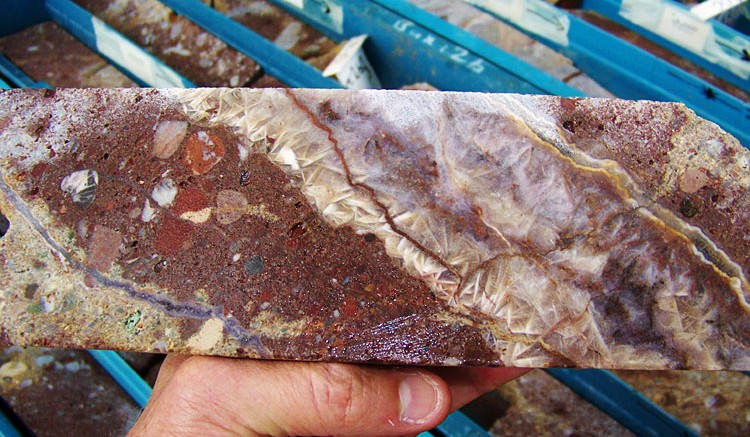VANCOUVER – After a busy 2012, Eurasian Minerals (EMX-V) is starting 2013 off with a bang: in its first news release of the year the company reported the highest-grade intercept to date at Akarca, the gold-silver project in northwest Turkey where Eurasian just regained full ownership.
The first two holes of the latest drill campaign at Akarca both returned long mineralized intercepts. Hole 70 cut 36.4 metres grading 5.67 grams gold per tonne and 53.31 grams silver per tonne, starting at surface and including 2.2 metres of 89.34 grams gold and 835.2 grams silver. Nearby, hole 69 returned 75.2 metres grading 0.6 gram gold and 4.48 grams silver from 4 metres downhole.
Both probed Sarikaya Tepe, a 500-metre-long zone that bears surface-exposed quartz veining and silicification along a steep northwest-trending ridge. Previous drilling at Sarikaya Tepe was angled across the zone from the west because there was no way to get drill rigs to the top of the ridge. Eurasian has now built a drill road up the ridge and these latest holes cut across the zone from the east.
The new road also exposed a new target zone on the east side of the prospect, a 200-metre-long zone of veining and silicification that EMX will drill test later in the year.
In fact, road construction has been a very useful exploration method for Eurasian at Akarca. The 39-sq. km property bears six known mineralized zones within a 9-sq. km area, which all host gold and silver in veins and as disseminations within silicified halos. The three best established zones at Akarca are Kucukhugla Tepe, Hugla Tepe, and Fula Tepe, which together make up the Central Target area. More recently Eurasian outlined three additional zones, known as Arap Tepe, Percem Tepe, and Sarikaya Tepe.
Collectively these targets boast some 14 km of prospective strike length, of which only 20% has been tested to date. As such, Eurasian is still exploring all six, while also conducting property-wide mapping, sampling, and geophysical surveys. And new drill roads are helping the effort.
At Fula Tepe, drill road construction also uncovered new mineralization. Trench samples across the broad silicified corridor returned almost continuous mineralization along 200 metres, including 169 metres of 0.66 gram gold and 8.66 grams silver. Another trench to the north returned 38 metres of 1.19 grams gold and 6.7 grams silver, while a third trench to the south also cut into mineralization.
Similarly, construction of a drill road at Arap Tepe exposed a silicified zone that extended the known width of the zone at surface. Trench sampling across the zone returned 55.5 metres of 1.27 grams gold.
Until recently Akarca was a joint venture between Eurasian, which discovered mineralization at the site, and Centerra Gold, which spent $5 million at the project to earn a 50% stake. In October the partners announced a deal whereby Eurasian regained full ownership of Akarca in return for relieving Centerra of certain exploration and payment obligations.
Turkey is becoming quite the sweet spot for Eurasian. The company holds a 4% net smelter royalty on the Balya project, which is also in the country’s northwest and which Eurasian sold to private Turkish company Dedeman in 2006. Now Dedeman’s drills are hitting into high-grade intercepts and the company is advancing the property to production, with plans to start underground mine development this year.
The main zone at Balya, Hastanetepe, is a moderately dipping area of stacked lead-silver-zinc mineralization hosted in limestones and dacites. Drilling at the zone in 2012 intersected new horizons to the east and southeast with high grades over thicker intervals than previously encountered.
For example, hole 67 cut 2.6 metres of 52.87% lead, 18.67% zinc, and 1,311.9 grams silver from 37 metres dowhnhole, followed by 18 metres grading 10.99% lead, 5.96% zinc, and 126.6 grams silver from 75 metres depth. Nearby, hole 74 returned 22.3 metres of 6.95% lead, 2.1% zinc, and 1,435 grams silver from 25 metres depth, while hole 81 hit 18 metres grading 13.83% lead, 4.68% zinc, and 110 grams silver.
Eurasian also continues to advance its portfolio of projects in Haiti, some of which are being explored by Newmont Ventures through a long-standing joint venture. In addition, the company owns 36% of private exploration company InterGeo Resources, which is having success as it explores the Malmyzh porphyry copper-gold projhect in Russia’s Far East. Recent drill results from the property include 111.6 metres averaging 0.8% copper and 1.01 grams gold and 406.7 metres grading 0.52% copper and 0.29 gram gold.
News of the latest drill results from Akarca added 2¢ to Eurasian’s share price, bringing it to $2.03. The company has a 52-week share price range of $1.66 to $2.75 and has 72 million shares outstanding.


Be the first to comment on "Eurasian hits highest grades to date at Akarca"